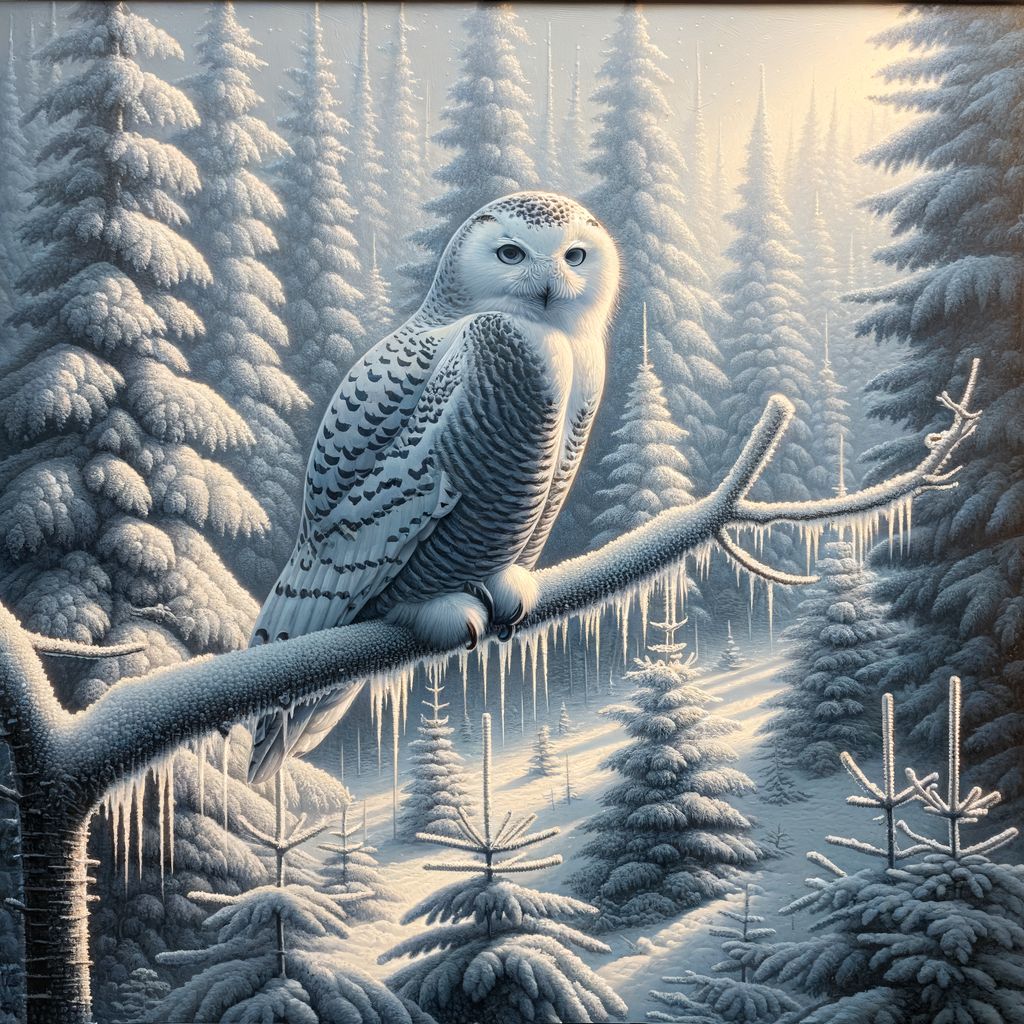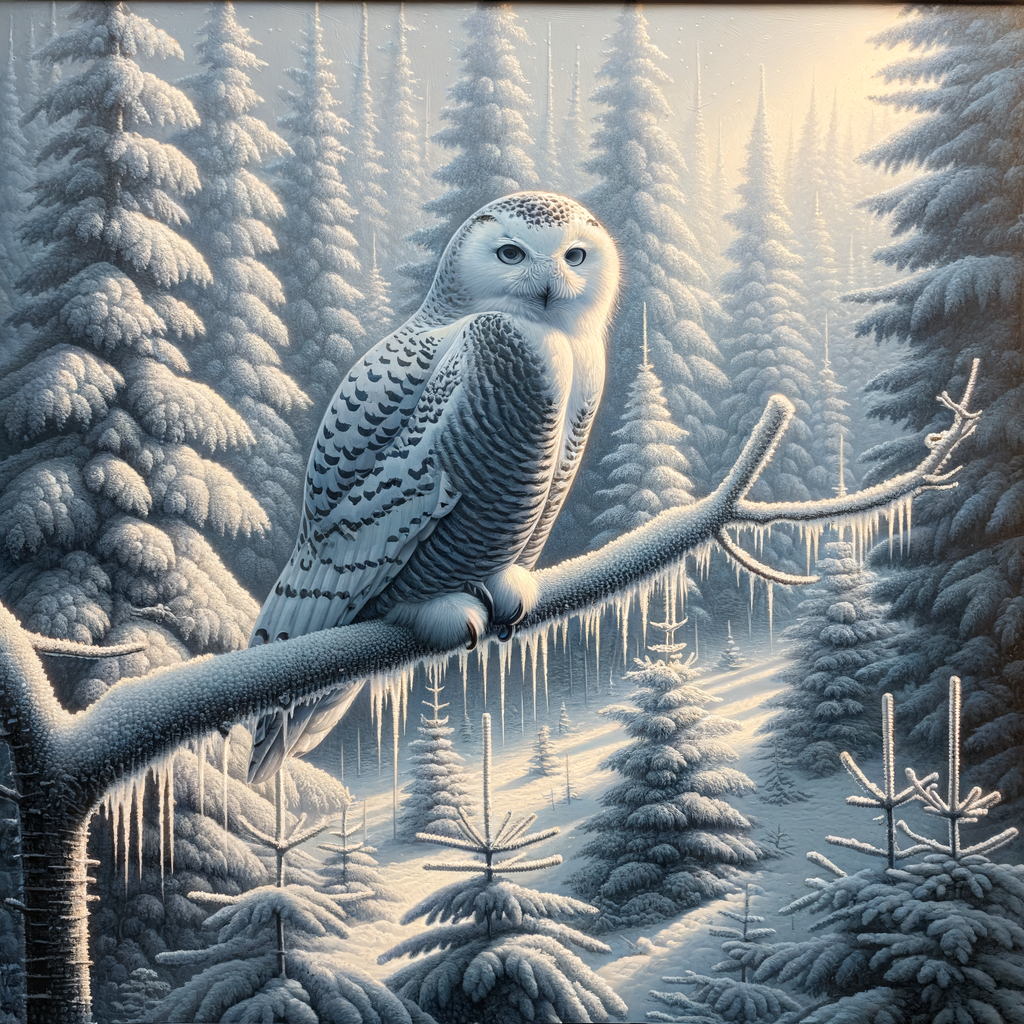
Introduction to Owl Seasonal Adaptation
- The concept of seasonal adaptation: Seasonal adaptation refers to how animals change their behavior, physical traits, or habitat use to survive different seasons. For owls, this means adjusting to changes in temperature, food availability, and daylight hours.
- Importance of seasonal adaptation for owls: Seasonal adaptation is crucial for owls because it helps them find food, stay warm, and reproduce. Without these changes, owls would struggle to survive in their natural habitats.
Owl Behavior Changes in Different Seasons
Owls in Winter
- Physical adaptations of owls in winter:These feathers are thicker and fluffier, providing extra insulation against the cold. Some species, like the Snowy Owl, have almost pure white feathers, which help them blend into snowy environments. This camouflage helps them avoid predators and sneak up on prey.
- Behavioral changes of owls in winter:They often hunt during the day instead of at night because their prey, like mice and other small animals, are more active during daylight in the cold months. Owls also tend to be less vocal in winter to conserve energy. They might stay in one place longer to avoid wasting energy flying in the cold.
Owls in Summer
-
- Physical adaptations of owls in summer
During the summer, owls have unique physical adaptations to stay cool. Their feathers are less dense, allowing better airflow. This helps them avoid overheating. Owls also have special blood vessels in their legs that help release heat.
For example, the Barn Owl has lighter feathers in summer. This makes it easier for them to fly and hunt in warm weather.
-
- Behavioral changes of owls in summer
They are more active at night when it’s cooler. This is called nocturnal behavior. During the day, they find shady spots to rest. Owls also change their hunting habits. They hunt more frequently at dawn and dusk. This is when their prey, like mice and insects, are also active.
| Behavior | Summer Adaptation |
|---|---|
| Activity Time | More active at night |
| Resting Spots | Find shady areas |
| Hunting | Hunt at dawn and dusk |
Owl Migration Patterns
-
Factors Influencing Owl Migration Patterns
Owl migration is influenced by several factors. These include:
- Weather: Owls often migrate to avoid harsh weather conditions. For example, they may move to warmer areas during winter.
- Food Availability: When food is scarce, owls migrate to places where they can find more prey. This is especially true for species that rely on specific types of food.
- Breeding: Some owls migrate to find better breeding grounds. These areas might offer safer nesting sites or more food for their young.
-
Common Owl Migration Routes
Different species of owls have different migration routes. Here are some examples:
- Snowy Owls: These owls migrate from the Arctic to southern Canada and the northern United States. They travel long distances to find food during the winter.
- Short-eared Owls: These owls migrate from northern regions to the southern United States and Mexico. They prefer open areas like grasslands and marshes.
- Long-eared Owls: These owls migrate from Canada and the northern United States to the southern United States and Mexico. They often travel at night to avoid predators.
Owl Habitat Changes with Seasons
-
How Owls Adapt to Changing Habitats
In the winter, some owls grow thicker feathers to stay warm. They might also find new places to live, like inside hollow trees or barns, to keep out of the cold.
In the summer, owls may move to cooler, shaded areas to avoid the heat. They can also change their hunting times, becoming more active at night when it’s cooler. This helps them stay comfortable and find food more easily.
-
Impact of Habitat Changes on Owl Survival
If their usual homes are destroyed by storms or human activity, owls may struggle to find new places to live. This can make it harder for them to find food and stay safe from predators.
For example, when forests are cut down, owls lose their nesting sites. This can lead to fewer owl babies being born. Also, if the weather changes too much, it can affect the number of small animals that owls eat, making it harder for them to find enough food.
| Season | Owl Adaptation | Impact on Survival |
|---|---|---|
| Winter | Grow thicker feathers, find warm shelters | Helps stay warm and safe |
| Summer | Move to cooler areas, hunt at night | Helps avoid heat and find food |
Seasonal Diet of Owls
- How owls’ diet changes with seasons
- Impact of diet changes on owl health and survival
Owls are fascinating birds of prey known for their adaptability. One of the ways they adapt is through their diet, which changes with the seasons.
How Owls’ Diet Changes with Seasons
During different times of the year, the availability of food sources changes. In the spring and summer, owls have access to a variety of prey. They often hunt small mammals like mice, voles, and rabbits. They also catch insects and sometimes even small birds.
In the fall and winter, food becomes scarcer. Owls may have to travel further to find food. They might rely more on rodents, which are still active in colder weather. Some owls also store food to eat later during these tough months.
Impact of Diet Changes on Owl Health and Survival
When food is plentiful, owls can grow strong and healthy. They have enough energy to hunt and take care of their young.
However, when food is hard to find, owls may struggle. They might become weaker and more vulnerable to illness. Young owls, in particular, need a steady food supply to grow properly.
| Season | Common Prey | Challenges |
|---|---|---|
| Spring | Small mammals, insects, small birds | Finding varied prey |
| Summer | Small mammals, insects | Increased competition |
| Fall | Rodents, stored food | Preparing for winter |
| Winter | Rodents, stored food | Scarcity of prey |
Understanding how owls adapt their diet with the seasons helps us appreciate their resilience and survival skills. These birds are truly remarkable in their ability to thrive in changing environments.
Owl Breeding Season
-
- When is the owl breeding season?
Usually starts in late winter or early spring. This is the time when owls find mates and build nests. Different species of owls may have slightly different breeding times, but most follow this general pattern.
-
- How does the breeding season affect owl behavior?
During the breeding season, owls become more active and vocal. They hoot more often to attract mates and to defend their territory. Owls also become more aggressive during this time, especially when protecting their nests and young ones.
Owl Survival Strategies in Different Seasons
-
Survival Strategies of Owls in Winter
Winter can be tough for owls. The cold and snow make it hard to find food. Owls have special ways to survive during this season.
Thick Feathers: Owls grow thicker feathers to stay warm. These feathers trap heat and keep the owl cozy.
Silent Flight: Owls fly silently to sneak up on prey. This is very important in winter when food is scarce.
Hunting at Night: Owls hunt mostly at night. Their excellent night vision helps them find food even in the dark.
Storing Food: Some owls store extra food. They hide it in tree holes or other safe places to eat later.
-
Survival Strategies of Owls in Summer
Summer is a different challenge for owls. The heat and more predators can be problems. But owls have ways to handle these issues too.
Staying Cool: Owls stay in the shade during the hottest parts of the day. They also pant like dogs to cool off.
More Prey: There is more food in summer. Owls take advantage of this by hunting more often.
Camouflage: Owls blend in with their surroundings. This helps them hide from predators and sneak up on prey.
Raising Young: Summer is a good time for raising baby owls. There is plenty of food to feed the growing chicks.
Seasonal Challenges for Owls
-
- Major challenges faced by owls in different seasons
Owls face many challenges throughout the year. In winter, cold temperatures and snow make it hard to find food. During spring, heavy rains can flood their nests. Summer heat can be tough on young owls, and fall brings strong winds that can damage their homes.
-
- How owls overcome these challenges
Owls are very smart and have ways to deal with these problems. In winter, they grow thicker feathers to stay warm. They also hunt more at night when it is quieter. In spring, they build their nests in high places to avoid floods. During summer, they find shady spots to keep cool. In fall, they choose strong branches for their nests to withstand the wind.
| Season | Challenge | Solution |
|---|---|---|
| Winter | Cold and snow | Thicker feathers, night hunting |
| Spring | Heavy rains | High nests |
| Summer | Heat | Shady spots |
| Fall | Strong winds | Strong branches |
Conclusion: The Resilience of Owls
Owls are amazing creatures. They have many ways to adapt to different seasons. Let’s look back at what makes them so special.
- Recap of owls’ adaptation strategies: Owls change their behavior, migrate, and even alter their diets to survive. They are experts at finding food and shelter no matter the season.
- The importance of understanding and protecting owls: By learning about owls, we can help protect them. Owls play a key role in nature. They control pests and keep the balance in their habitats. Protecting owls means protecting our environment.
Owls show great resilience. They adapt to survive and thrive in different seasons. Understanding and protecting these birds is important for our ecosystem. Let’s work together to ensure owls continue to grace our skies.






